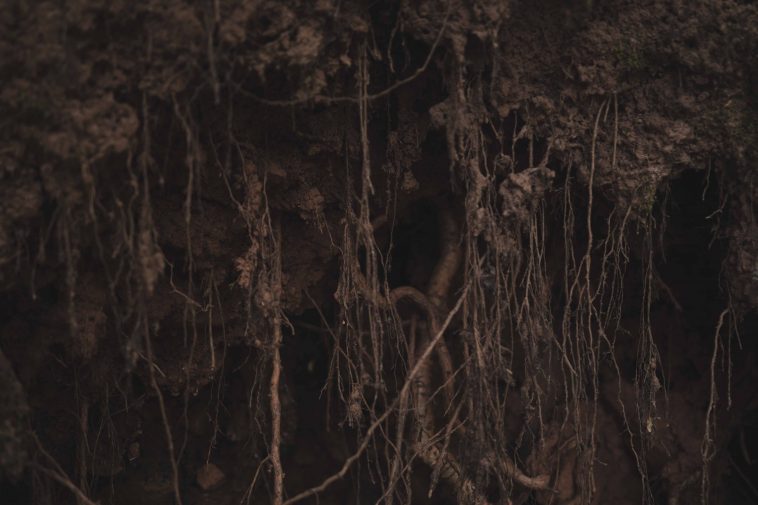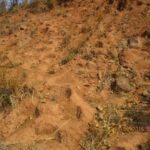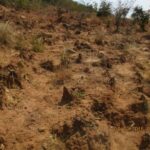Prevention is always better than cure. This is particularly true about soil erosion, where the slowing down of runoff water on a steep slope can prevent the formation of gullies and deep head-cuts.
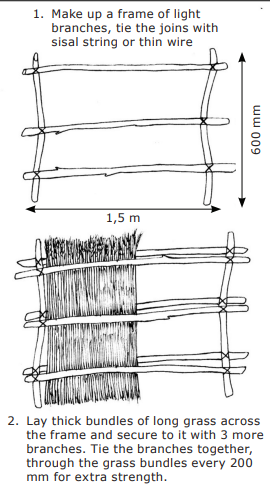
Figure 1: The manufacture of grass fence sections: 1 – Making the frame and 2 – Fitting bundles of grass to the frame. (Illustrations provided by Conservation Management Services).
Steep slopes that were stripped of plant material through the deforestation of the mountain slopes near the town of Mzuzu in Malawi, was tackled by the South African consultancy Conservation Management Services. Ken Coetzee and Wallie Stroebel were appointed by the Irish charity, Wells for Zoe, to help fight soil erosion in areas where the organisation is working on the Enyazini reforestation project.
Wells for Zoe focuses on providing wells and pumps for the community in this area, but they are also involved in restoring the soil by fighting erosion and the reforestation of the mountain slopes. For this purpose, they have set up a nursery where they are growing large numbers of indigenous trees.
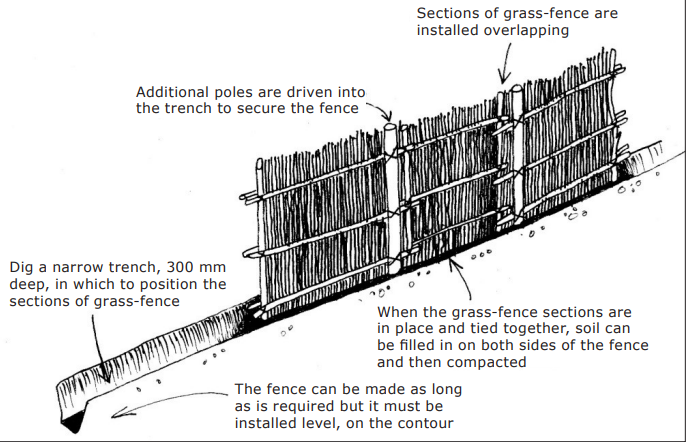
Figure 2: Installing the grass-fence sections in a trench with support poles.
In the previous two issues, we discussed how runoff water caused headcuts and gullies which were successfully treated by using available plant material such as branches, grass, and shrubs. In this issue, we discuss how they prevent soil erosion by slowing down the rush of runoff water on steep slopes which have hardly any vegetation cover to keep the rushing water in check. This causes nutrient-rich topsoil to wash away, ending up at the bottom of the slope and eventually in the nearest stream.
Solution
- Examples of bare slopes where erosion control is needed.
The solution was to construct grass fences by using branches and tall grass, and to install these along the contour lines of the eroded slope. These fences slow down the rushing water, holding back topsoil and seeds while allowing the water to sink into the soil.
Grass fences can be used on slopes and also on open ground where water runoff from irrigated agricultural fields often occurs.
Step by step treatment of a slope
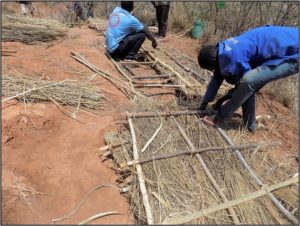
First, sections of grass fence are made up out of thin branches and long bundles of grass. The joints are all tied with thin wire or sisal.
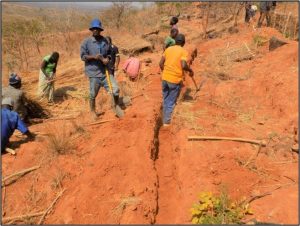
On the slope, ± 300 mm deep trenches are dug along the contour.
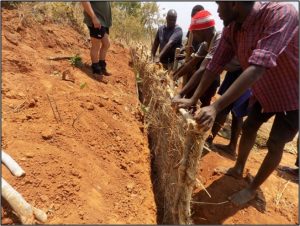
The sections of grass fence are fitted in the trench with the ends overlapping slightly.
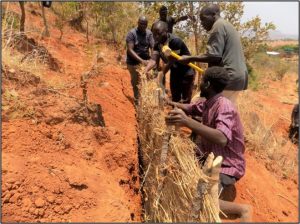
Additional poles are hammered in near the end of each section of the fence to stabilise it. Each pole is securely tied to the fence.
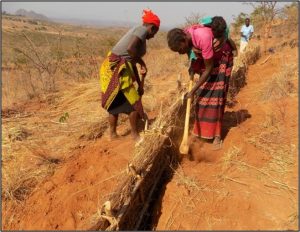
The trench is filled in with soil on both sides and well compacted.
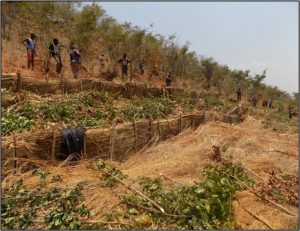
A ground cover of grass or leafy branches is placed on the bare ground on both sides of each fence.
First, several grass fence sections must be constructed. This is done by tying thick bunches of tall grass to a frame of branches, as shown in the images to the right. The fences must be about 600 to 700 mm high and 1,5 m wide.
Lay out and mark the contour lines of the slope along which the grass fence structures will be constructed. The contour lines, and the grass fences, must be as level as possible.
Dig a foundation trench of between 300 mm to 400 mm deep and 200 mm wide along the contour line.
Fit the grass fence panels into the trench so that they overlap by 150 mm.
Hammer in support poles 1,2 m apart. Secure the grass fence panels to the support poles with wire or sisal string. The spacing of the support poles allows a 150 mm overlap on each side of the 1,5 m grass fence panels to make them sturdier.
Fill the trench with the soil that was removed when the trench was dug, and compact the soil on both sides of the structure.
Pack brush or leafy branches on the bare soil on both sides of the fences where the soil has been disturbed by digging.
Lastly, the steeper the slope, the closer the grass-fences must be to each other. On steep slopes the fences must be no more than 5 m apart. Fences that are close together will prevent water from rushing down the slope, picking up momentum and accelerating the soil erosion problem.
Important note
The materials needed for the construction of the soil erosion control structures are all freely available locally, but care must be taken to cut the poles, branches, and brush-packing materials in such a way that the area near the working area is not stripped bare. This may mean that plant material must be collected some distance away from where the fences are being constructed. The community members are used to working in the fields with basic farming implements. The instructions are easy to follow and simple to implement, but it is critical that erosion control must be followed up with inspection after rain, and that regular repairs must be done timeously.
Contact details:
Ken Coetzee, Wallie Stroebel and Bruce Taplin
4 Chestnut Street, Heather Park, George, 6529, South Africa
Cell Ken: +27 76-227-5056; Wallie +27 82-493-1441
Website: www.conservationmanagementservices.co.za

